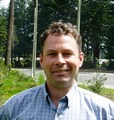ANNOUNCEMENT: Cowichan Valley Forum is provincial pilot for building developer and local government capacity to apply the Water Balance Model (2008)

Living Water Smart
By 2012, provincial water laws will improve the protection of ecological values, provide for more community involvement, and provide incentives to be water efficient. This legislation will recognize water flow requirements for ecosystems and species. In addition, green developments waiting for approval will be fast-tracked.
- What does this mean to those involved in land development or redevelopment?
The Province and local government are collaborating to develop a suite of user-friendly tools and approaches for assessment purposes and to provide consistency when reviewing development applications. The web-based Water Balance Model for British Columbia (WBM) is one of these tools.

What is the Cowichan Valley Water Balance Model Forum?
On October 17, 2008 the Cowichan Valley Regional District (CVRD) is hosting a Water Balance Model Forum in collaboration with the Inter-Governmental Partnership which developed this scenario modelling and decision support tool.
The Forum is organized under the umbrella of Convening for Action on Vancouver Island (CAVI), and was by “by invitation”.
 “The provincial and regional water regulations are changing, and by 2012 provincial water laws will substantially change how development occurs. The purpose of the workshop is to review progressive rainwater/stormwater management techniques and how they can be incorporated into the planning and development process,” wrote Jack Peake, Chair of the Cowichan Valley Regional Board, in his letter of invitation to land developers and consultants.
“The provincial and regional water regulations are changing, and by 2012 provincial water laws will substantially change how development occurs. The purpose of the workshop is to review progressive rainwater/stormwater management techniques and how they can be incorporated into the planning and development process,” wrote Jack Peake, Chair of the Cowichan Valley Regional Board, in his letter of invitation to land developers and consultants.
To Learn More:
Download Announcement for Cowichan Water Balance Forum – October 2008.
Download a copy of the Invitation from the Chair of the Cowichan Valley Regional Board.
Inclusive and Collaborative
“The Cowichan Valley is the pilot region for an inclusive and collaborative approach to building capacity through education and training,” explains Jay Bradley (Ministry of  Agriculture & Lands), Chair of the Vancouver Island Coordinating Team, a sub-group of the Inter-Governmental Partnership.
Agriculture & Lands), Chair of the Vancouver Island Coordinating Team, a sub-group of the Inter-Governmental Partnership.
“The Forum will be conducted as a hybrid-training workshop to inform, educate and enable those who wish to apply the Water Balance Model to support a Design with Nature approach to land development.”
Sharing, Exploration and Cross-Fertilization
 “The Forum is an outcome of the Cowichan Valley Learning Lunch Seminar Series, also a provincial pilot,” continues Kate Miller (CVRD Environment Manager), Chair of the Cowichan Valley Organizing Team.
“The Forum is an outcome of the Cowichan Valley Learning Lunch Seminar Series, also a provincial pilot,” continues Kate Miller (CVRD Environment Manager), Chair of the Cowichan Valley Organizing Team.
“We are describing the Forum as a hybrid-training workshop because the day will be built around case study applications of the Water Balance Model. These will provide the technical foundation for roundtable sharing, exploration and cross-fertilization of ideas on how to implement green infrastructure effectively.”
Runoff-based Performance Targets
 “The case study applications will build a common understanding of how to achieve runoff-based performance targets for rainwater management and green infrastructure,” elaborates Rob Conway, Assistant Manager, CVRD Development Services.
“The case study applications will build a common understanding of how to achieve runoff-based performance targets for rainwater management and green infrastructure,” elaborates Rob Conway, Assistant Manager, CVRD Development Services.
“What is unique about our approach is the educational context. Willing owners/developers and their planning/design consultants have volunteered to develop and share the case studies. It truly is a collaborative effort.”
Common Understanding
 “The educational approach is helping us to identify and empower a core group of local champions who will then have the expertise to apply and advance the water balance approach to land development,” adds Peter Nilsen, Deputy Engineer with the District of North Cowichan.
“The educational approach is helping us to identify and empower a core group of local champions who will then have the expertise to apply and advance the water balance approach to land development,” adds Peter Nilsen, Deputy Engineer with the District of North Cowichan.
“This building of practitioner capacity encompasses both local government and the development community. Project proponents and reviewers will have a common language.”
Meeting Expectations
 “The Inter-Governmental Partnership is providing each case study team with technical support by making Jim Dumont, the WBM Engineering Applications Authority, available to guide them through the process,” concludes Kim Stephens, Program Coordinator for the Water Sustainability Action Plan for British Columbia, and leader of the WBM teaching/facilitation team.
“The Inter-Governmental Partnership is providing each case study team with technical support by making Jim Dumont, the WBM Engineering Applications Authority, available to guide them through the process,” concludes Kim Stephens, Program Coordinator for the Water Sustainability Action Plan for British Columbia, and leader of the WBM teaching/facilitation team.
“Our goal is that everyone will have a successful experience on October 17, and there will be a clear understanding of how to meet expectations.”
How the WBM Forum will be structured
According to Kim Stephens, the Forum will be structured in two parts: “The theme in the morning is Establishing Expectations. The afternoon theme is Meeting Expectations. Part One will present the local government perspective.”
“By developing a common understanding of expectations, this will set the stage for Part Two and a detailed discussion of the case studies.”
“In the first hour of Part Two, each case study team will share their experience in applying the Water Balance Model, the outputs they generated, and how the process has influenced their thinking,” continues Kim Stephens.
“The case study sharing will inform a roundtable discussion in the second hour on the topic of: How do you know when you have been successful?”
What is the Water Balance Model?
The new ‘Water Balance Model powered by QUALHYMO’ is unique, bridges engineering and planning, links development sites to the stream and watershed, and enables local governments to establish science-based runoff performance targets.
Further, the WBM enables experienced users to correlate green infrastructure effectiveness in protecting stream health. Web-based and public domain, the WBM is available to any and all at www.waterbalance.ca.
This tool is the computational and communication backbone that will take British Columbia towards the sustainable reality of a greening of the built environment.



